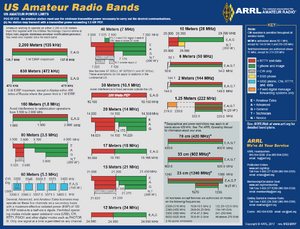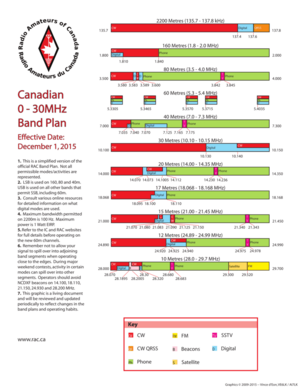Band Plans: Difference between revisions
Jump to navigation
Jump to search
Tag: Reverted |
Tags: Rollback Reverted |
||
| Line 1: | Line 1: | ||
A collection of some band plans describing the frequency allocations for each ham band. | A collection of some band plans describing the frequency allocations for each ham band. | ||
== United States == | ==United States (ARRL)== | ||
[[File:ARRL Band Plan.png|alt=An image created by the ARRL describing the United States amateur radio frequency allocations per band and per class.|thumb | [[File:ARRL Band Plan.png|alt=An image created by the ARRL describing the United States amateur radio frequency allocations per band and per class.|thumb|An image created by the ARRL describing the United States amateur radio frequency allocations per band and per class.]] | ||
]] | |||
The US Band plan consists of frequency allocations for amateurs on bands from 2200 meters to 23 centimeters. | |||
[http://www.arrl.org/files/file/Regulatory/Band%20Chart/Band%20Chart%20-%2011X17%20Color.pdf Original document] | |||
==Canada== | ==Canada== | ||
[[File:Canadian Band Plan.png | <blockquote>Basic: All bands above 30MHz. All other classes: Every band. {.is-info}</blockquote> | ||
===Canada HF=== | |||
[[File:Canadian Band Plan.png|thumb]] | |||
An image created by the RAC describing the Canadian amateur radio frequency allocations per band is accompanied to the right side. Keep in mind - this only includes all frequencies available to amateur operators, and does not include class designations. | |||
[https://www.rac.ca/rac-0-30-mhz-band-plan/ Original Document] | |||
===Canada VHF/UHF=== | |||
There is no singular offical chart for bands above 30MHz, instead there are [https://www.rac.ca/operating/bandplans/ charts per band]. | |||
==New Zealand== | ==New Zealand== | ||
The NZART provides a [https://www.nzart.org.nz/assets/info/band-plans/2021-bandplan.pdf very detailed plan] that is not possible to embed here. | The NZART provides a [https://www.nzart.org.nz/assets/info/band-plans/2021-bandplan.pdf very detailed plan] that is not possible to embed here. | ||
Revision as of 21:43, 5 June 2023
A collection of some band plans describing the frequency allocations for each ham band.
United States (ARRL)

The US Band plan consists of frequency allocations for amateurs on bands from 2200 meters to 23 centimeters.
Canada
Basic: All bands above 30MHz. All other classes: Every band. {.is-info}
Canada HF

An image created by the RAC describing the Canadian amateur radio frequency allocations per band is accompanied to the right side. Keep in mind - this only includes all frequencies available to amateur operators, and does not include class designations.
Canada VHF/UHF
There is no singular offical chart for bands above 30MHz, instead there are charts per band.
New Zealand
The NZART provides a very detailed plan that is not possible to embed here.